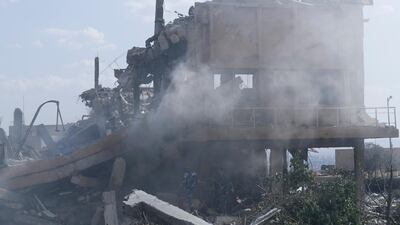Air attacks on chemical weapons sites early Saturday failed to strike at the heart of Syria’s illegal programme despite US claims that the mission had been a success, according to a former officer of the project.
The Pentagon said targeted strikes at three sites had “significantly degraded” the ability of Bashar Al Assad’s regime to wage attacks but Captain Adulsalam Abdulrazek said they probably hit “parts of, but not the heart” of the operation.
Captain Abdulrazek defected in 2013 when there were an estimated 50 warehouses storing chemical weapons, he told the Associated Press from rebel-held northern Syria. He said many of those were not dismantled despite a commitment by Syria to abolish its programme under US pressure in 2013.
US officials also said it was “highly likely” that Assad kept an undisclosed stockpile and a continued capacity to produce agents.
The US targeted two sites near Homs and launched a 76-missile fusillade against a branch of the Scientific Studies and Research Centre (SSRC) in the northern Damascus suburb of Barzeh.
Following Saturday’s attack, France released an intelligence assessment which also said that Syria had failed to declare many of the activities of the SSRC until recently, including at Barzeh.Officials from Russia, an ally of Syria, said that Saturday’s damage was minimal and the purported chemical weapons facilities had been abandoned long ago.
“SSRC is the Syrian government agency responsible for developing and producing non-conventional weapons and the missiles to deliver them,” according to the US Treasury which designated the body a weapons of mass destruction (WMD) centre in 2005 with the aim of freezing its assets. “Its activities focus substantively on the development of biological and chemical weapons.”
______________
Read more:
Syrian citizens and rebels expect no change after missile strikes
The strikes in Syria need a long-term goal
______________
A Western intelligence document secured by the BBC in 2017 said that Barzeh was one of three SSRC sites where chemical weapons were made. The report by the intelligence agency, which was not named, said that the Barzeh facility specialised in putting chemicals into munitions. The other two SSRC sites were reportedly hit by Israeli strikes last year.
The director of the SSRC, Amr Armanzi, was blacklisted in 2012 by the administration of Barack Obama for allegedly overseeing the production of chemical weapons.
Treasury officials said that during his tenure he “oversaw a facility that was involved in the production of sarin nerve agent”.
Sarin was used in the attack in Khan Sheikhoun last year which killed more than 80 people and resulted in Mr Trump ordering a retaliatory airstrike against Syria last April.
Despite the designation, Mr Armanzi’s two sons and his brother hold UK passports and are living in affluent parts of Britain, according to the Sunday Times. Britain was one of the three countries involved in the air strikes against Syrian targets along with France and the US.


